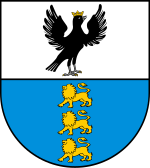Stanisławów Voivodeship
The Stanisławów Voivodeship (also Stanislau Voivodeship in Polish Województwo Stanisławowskie ) was a Voivodeship of the Second Polish Republic from 1921 to 1939 . The seat of the administration and the capital was Stanisławów ( Stanislau , today Ivano-Frankivsk ).
| Stanisławów Voivodeship | |||
|
|||

|
|||
|---|---|---|---|

location and size
The voivodeship with the cities of Stanisławów , Kołomyja , Stryj , Knihinin (until 1925), Śniatyn , Turka and Horodenka extended over the eastern part of southern Poland .
They bordered on the northwest by the province Lviv , in the northeast of the province Tarnopol , on the east by Romania and on the southwest by the Czechoslovakia .
In the northern part the landscape is hilly and in the south mountainous ( Carpathian Mountains ), the Dniester flows across the area .
In 1921 the voivodship covered an area of 18,368 km². The 29 cities and 904 rural communities were divided into 15 powiats . When the Powiat Turka was spun off into the Lemberg Voivodeship in 1931, the area of the Voivodeship was only 16,894 km² in 1939.
history
The voivodeship was established after the Peace of Riga at the end of the Polish-Soviet War on September 1, 1921 in the southeastern parts of the former Austrian crown land of Galicia, with Stanisławów as the capital .
On April 1, 1929, the powiat Peczeniżyn was dissolved and the area joined the powiat Kołomyja . On April 17, 1931, the powiat Turka was ceded to the Lviv Voivodeship, on April 1, 1932, the powiat Bohorodczany was dissolved and its area was divided between the powiat Nadwórna and Stanisławów , on the same day the powiat Skole was dissolved and the area to the powiat Stryj allocated.
In September 1939, during World War II, the voivodeship was occupied by the Soviets during the Soviet occupation of eastern Poland and by Germany after the attack on the Soviet Union in 1941 . After the end of World War II, the area of the voivodeship became part of the Soviet Union ( Ukrainian SSR ).
population
The population in 1921 was 1.348 million, of which 22% Poles, 7% Jews and in 1931 1.466 million, of which 23% Poles and 7% Jews. The vast majority of the population (940 555 residents) were Ukrainians.
Administrative subdivision (1934)
Powiat Dolina consisting of the cities of Bolechów , Dolina and Rożniatów as well as the Gminas :
Powiat Horodenka consisting of the city of Horodenka and the Gminas :
- Czernelica
- Czerniatyn
- Horodenka
- Niezwiska
- Obertyn
- Siemakowce
- Tyszkowce
Powiat Kałusz consisting of the city of Kałusz and the Gminas :
Powiat Kołomyja consisting of the cities Kołomyja and Peczeniżyn as well as the Gminas :
Powiat Kosów consisting of the cities of Kosów and Kuty as well as the Gminas :
Powiat Nadwórna consisting of the cities of Delatyn and Nadwórna as well as the Gminas :
Powiat Rohatyn consisting of the cities Bołszowce , Bursztyn and Rohatyn as well as the Gminas :
- Podkamień
- Rohatyn
- Puków
- Knihynicze
- Koniuszki
- Lipica Dolna
- Żurów
- Bukaczowce
- Bursztyn
- Bołszowce
- Konkolniki
Powiat Stanisławów consisting of the cities Stanisławów, Bohorodczany and Halicz as well as the Gminas :
Powiat Stryj consisting of the cities of Skole and Stryj and the Gminas :
Powiat Śniatyń consisting of the towns of Śniatyn and Zabłotów and the Gminas :
- Mikulińce
- Zabłotów
- Zadubrowce
- Dżurów
- Stecowa
- Załucze
- Wołczkowce
Powiat Tłumacz consisting of the cities of Otynia , Tłumacz and Tyśmienica as well as the Gminas :
- Chocimierz
- Markowce
- Niżniów
- Olesza
- Otynia
- Roszniów
- Tarnowica Polna
- Tłumacz
- Oleszów
Powiat Żydaczów consisting of the towns of Mikołajów n / Dn ., Rozdół , Żurawno and Żydaczów as well as the Gminas :
September 1939 and its aftermath
In September 1939, German and Soviet troops invaded Poland, with the country and the Stanisławów Voivodeship being incorporated into the Ukrainian Soviet Republic. After 1945 the area remained with the Soviet Union, today the former Stanisławów Voivodeship belongs to large parts of the Ukrainian Oblast Ivano-Frankivsk and smaller parts of the Oblast Lviv .
Footnotes
- ↑ Der Grosse Brockhaus: Handbuch des Wissens, Volume 14, 1933
- ↑ https://web.archive.org/web/20170930231022/http://www.szukamypolski.com/strona/wojewodztwo/11
- ↑ Jew. According to the official population census in 1921 and 1931.

